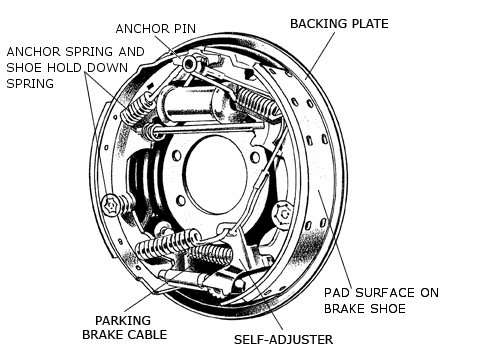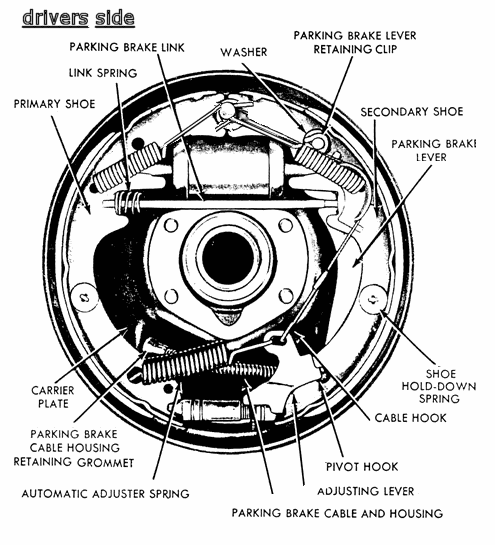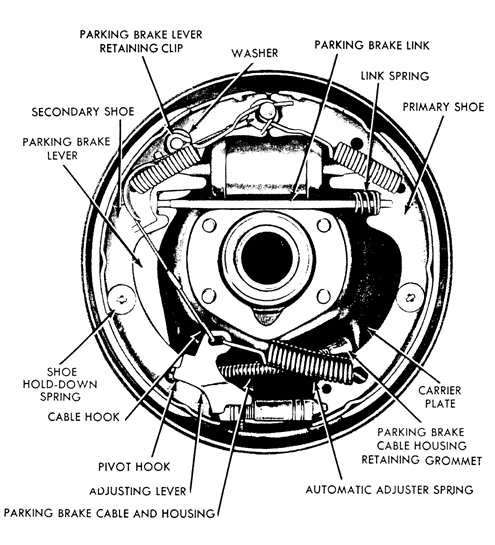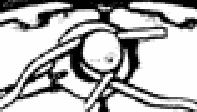Difference between revisions of "Drum Brakes on a Ford Mustang"
(New page: '''<font size="+1">Lazygirl Fixes Drum Brakes on a Ford Mustang</font>'''<br />''by Lisa Winterstien'' Being tired of opportunist mechanics and excessive labor charges, I decided that the...) |
m |
||
| Line 7: | Line 7: | ||
Without further ado, here's how it's done: Changing driver side and passenger side brake shoes/pads on a Ford Mustang with drum brakes. | Without further ado, here's how it's done: Changing driver side and passenger side brake shoes/pads on a Ford Mustang with drum brakes. | ||
| − | + | ===Illustration A: Driver Side Brake Drum Overview=== | |
[[Image:drumbrakeillustration.gif|illustration]] | [[Image:drumbrakeillustration.gif|illustration]] | ||
| Line 17: | Line 17: | ||
Remove the drum: I released the emergency brake or I wouldn't be able to remove the drum. I removed both driver and passenger side rear wheels and drums so I can look off of one side while working on the other, in case I forget where something goes. There are a lot of parts in drum brakes, including many springs, which hold the entire apparatus together. | Remove the drum: I released the emergency brake or I wouldn't be able to remove the drum. I removed both driver and passenger side rear wheels and drums so I can look off of one side while working on the other, in case I forget where something goes. There are a lot of parts in drum brakes, including many springs, which hold the entire apparatus together. | ||
| − | + | ===Illustration B: Driver Side Brake Drum Assembly=== | |
[[Image:drumbrakedriver.gif|illustration]] | [[Image:drumbrakedriver.gif|illustration]] | ||
| Line 23: | Line 23: | ||
The passenger side is a mirror of the driver's side, basically everything is the same, but in reverse. For each side there is a primary and secondary shoe. They may look identical at a quick glance, but it is very important to note the difference. The primary shoe has less of the actual pad and it always goes on facing the front of the car. | The passenger side is a mirror of the driver's side, basically everything is the same, but in reverse. For each side there is a primary and secondary shoe. They may look identical at a quick glance, but it is very important to note the difference. The primary shoe has less of the actual pad and it always goes on facing the front of the car. | ||
| − | + | ===Illustration C: Passenger Side Brake Drum Assembly=== | |
[[Image:drumbrakepassenger.gif|illustration]] | [[Image:drumbrakepassenger.gif|illustration]] | ||
| Line 29: | Line 29: | ||
Note the difference in the way the anchor springs hook onto the anchor pin between the two sides. The front anchor spring hooks onto the pin from the bottom on the driver side and over the top on the passenger side. | Note the difference in the way the anchor springs hook onto the anchor pin between the two sides. The front anchor spring hooks onto the pin from the bottom on the driver side and over the top on the passenger side. | ||
| − | + | ===Illustration D: Anchor Spring Attaches to Anchor Pin=== | |
[[Image:drumbrakeanchorpin.gif|illustration]] | [[Image:drumbrakeanchorpin.gif|illustration]] | ||
| Line 49: | Line 49: | ||
Adjusting Screw and Assembly: Next I applied brake shoe grease to the threads on the adjusting screw and backed the screw all the way to the end (so the apparatus is at its shortest) but not tightly. Installing the adjusting screw (four pieces back up the adjusting screw: threaded pin, socket, washer, and wheel) was done by placing it in the correct notches between the two shoes. | Adjusting Screw and Assembly: Next I applied brake shoe grease to the threads on the adjusting screw and backed the screw all the way to the end (so the apparatus is at its shortest) but not tightly. Installing the adjusting screw (four pieces back up the adjusting screw: threaded pin, socket, washer, and wheel) was done by placing it in the correct notches between the two shoes. | ||
| − | + | ===Illustration E: Adjusting Screw and Assembly=== | |
[[Image:drumbrakeadjscrew.gif|illustration]] | [[Image:drumbrakeadjscrew.gif|illustration]] | ||
Latest revision as of 09:20, 24 June 2007
Lazygirl Fixes Drum Brakes on a Ford Mustang
by Lisa Winterstien
Being tired of opportunist mechanics and excessive labor charges, I decided that there is no logical reason why I shouldn't be able to replace the brake pads in my Ford Mustang at home. Since it was a first for me, I read the process in a Chilton's guide and sought some advice from someone experienced with brake pad replacement.
After a trip to O'Reilly Auto Parts store, new brake shoes in hand, I was ready to begin brake pad service on the car. It is important to note that it is worth the extra money to get brake shoes with the "metal flake" pads because they last longer and are much less likely to develop that annoying squeaky brake sound. Since drum brakes are a bit of a chore to service, it is worth one's time investing in good quality pads that will last longer.
Without further ado, here's how it's done: Changing driver side and passenger side brake shoes/pads on a Ford Mustang with drum brakes.
Contents
Illustration A: Driver Side Brake Drum Overview
Jack up the car: I blocked the front wheels and scooted a floor hydraulic jack under the center of the rear end and jacked the car up high enough to get both wheels off the ground. I placed jack stands under the rear axle on both sides.
Remove wheel: My Mustang has four lugs, which I removed so that I could take the tire off. I put the emergency brake on inside the car so the wheels wouldn't spin while I was loosening the lugs. Some people loosen them before jacking up the car. I find the e- brake holds the wheels sufficiently well.
Remove the drum: I released the emergency brake or I wouldn't be able to remove the drum. I removed both driver and passenger side rear wheels and drums so I can look off of one side while working on the other, in case I forget where something goes. There are a lot of parts in drum brakes, including many springs, which hold the entire apparatus together.
Illustration B: Driver Side Brake Drum Assembly
The passenger side is a mirror of the driver's side, basically everything is the same, but in reverse. For each side there is a primary and secondary shoe. They may look identical at a quick glance, but it is very important to note the difference. The primary shoe has less of the actual pad and it always goes on facing the front of the car.
Illustration C: Passenger Side Brake Drum Assembly
Note the difference in the way the anchor springs hook onto the anchor pin between the two sides. The front anchor spring hooks onto the pin from the bottom on the driver side and over the top on the passenger side.
Illustration D: Anchor Spring Attaches to Anchor Pin
Unhook Anchor Springs: Using a special tool I purchased at Sears I removed both anchor springs by carefully unhooking them from the anchor pin. The tool basically has a cup end that when rotated slips the spring hook safely off the anchor pin.
Remove Hold Down Spring: I also have a special tool for this task, but it is a useless piece of rubbish. I ended up using a hex nut driver that I could push in on the hold down spring without contacting the center pin. I used my other hand to reach around behind and turn the ping 90 degrees so when the spring was released, it would be free from the pin. This makes the task of removing the shoe hold down spring much easier. Be sure to pull the pin out from the rear.
Anchor Pin Plate: Through careful observation of the anchor pin plate I became aware of its orientation, which I will remember for when it comes time to place it back on the anchor pin. It is behind (front to back) the anchor springs and cable eye. At this point it is easy to disassemble the rest of the assembly. Everything will basically just fall apart with a little work. I leave the parking brake lever attached since there is no need to remove it despite what the Chilton text suggests.
Install New Shoes and Hold Down Springs: I Applied brake shoe grease to the backing plate where the shoes will make contact with it taking care not to get grease on the brake pads. First I placed the primary shoe in position facing the front of the car. I then installed the secondary shoe which needs to be attached to the parking brake lever. The parking brake lever has a metal hook that goes into a square notched out hole on the top of the shoe. Holding this in place and putting the the parking brake link in-between the primary and secondary shoes is a bit tricky. I made sure the link spring is on the correct side with the primary shoe. The parking brake link hooks over the secondary shoe and parking brake lever both. So I put the shoe hold down springs back on next as to hold the shoes in place, otherwise they would just fall off. This is a bit of a balancing act that was easier to accomplish when I enlisted an extra set of hands.
Anchor Pin Plate and Cable Eye: Although the above illustrations fail to show one, I had an anchor pin plate which needed to be placed on after the shoes and before the cable eye and anchor springs. The anchor pin plate needed to be pressed firmly all the way in to make room for the next three things, which go on the anchor pin.
Attach Primary Anchor Spring: The anchor spring for the primary shoe goes on first. I hooked the anchor spring by putting the spring hook through the appropriate hole on the primary shoe, then using a special tool I pulled the spring up around the anchor pin.
Cable, Cable Eye, Cable Guide, and Secondary Shoe Anchor Spring: By Placing the cable eye over the anchor pin and placing the cable guide on the secondary shoes so that the hole is lined up where the spring hook inserts I was next ready to hook the spring into the hole though the cable guide and using the special tool. I pulled with the tool to hook the other end of the spring over the anchor pin.
Adjusting Screw and Assembly: Next I applied brake shoe grease to the threads on the adjusting screw and backed the screw all the way to the end (so the apparatus is at its shortest) but not tightly. Installing the adjusting screw (four pieces back up the adjusting screw: threaded pin, socket, washer, and wheel) was done by placing it in the correct notches between the two shoes.
Illustration E: Adjusting Screw and Assembly
The cable hook now needed to be hooked to the adjusting lever. I placed the hook in the appropriate hole on the adjusting lever along with one end of the automatic adjuster spring. I took great care in making sure the cable followed the cable guide down the side of the secondary shoe, not slipped in between the shoe and guide, and not slipping off the front, but right on top wrapped around tightly. I slipped the pivot hook of the adjuster lever in the appropriate hole on the secondary shoe and then pulled the automatic adjuster spring over and snap the end into the appropriate hole on the primary shoe by simply poking the hook into the hole until it snapped.
The adjusting screw actually fell out while I was trying to connect the adjuster lever and automatic adjuster spring, however, I proceeded until the adjuster lever is installed properly anyway. It was possible (with a little help) for me to force the adjusting screw into place once the lever, spring, and cable are all connected properly. The most important thing is that I made sure the adjuster lever pivot hook stayed in the secondary shoe. It must also sit on top of the adjusting screw so that the teeth of the wheel on the adjusting screw click past the lever properly.
I had to grab onto both shoes and shift them about some to get them seated properly. The top of the shoes has a notch that goes up against the anchor pin. I had to push some pinching the shoes inward towards each other so that they seated up against the anchor pin and at the bottom were holding the adjuster screw in place. I was able to line them up and push them together to where they held in place properly from all of the springs and assembly before placing the drum back on over the assembly.
These drum brakes are auto adjusting, to compensate for brake pad wear so that the pads always press tightly against the drum when the brakes are applied. It is the function of that adjuster screw to lengthen itself automatically as the brake pads wear.
After I placed the drum and wheel back on, tightening the lugs sufficiently, and lowering the car to the ground, I took it for a short drive onto the street in front of my house. I went forward a few feet and then in reverse. Driving in reverse will cause the adjuster screw to compensate for any unnecessary space so that your brakes will function correctly. If the brakes do not seem strong at first it is likely due to the fact the adjuster screw has not yet fully compensated, or you accidentally got a bit of grease on the pads.
I'm not a mechanic by any measure, I am a computer geek. However, this is not rocket science and although it was a bit tricky at times, it is simple enough that I would feel comfortable doing it again.
-Lazygirl Sun Sep 25 19:56:10 CDT 2005





